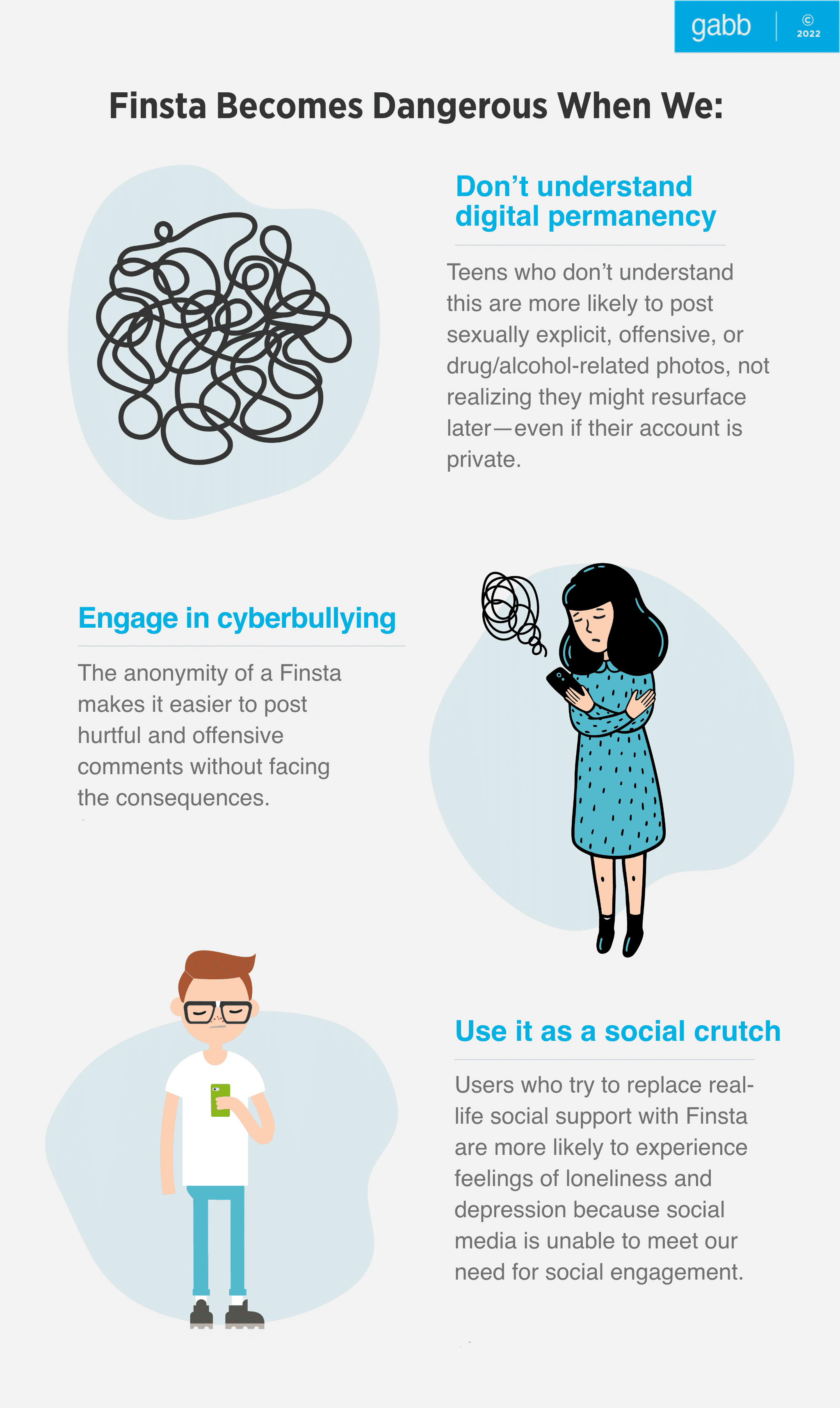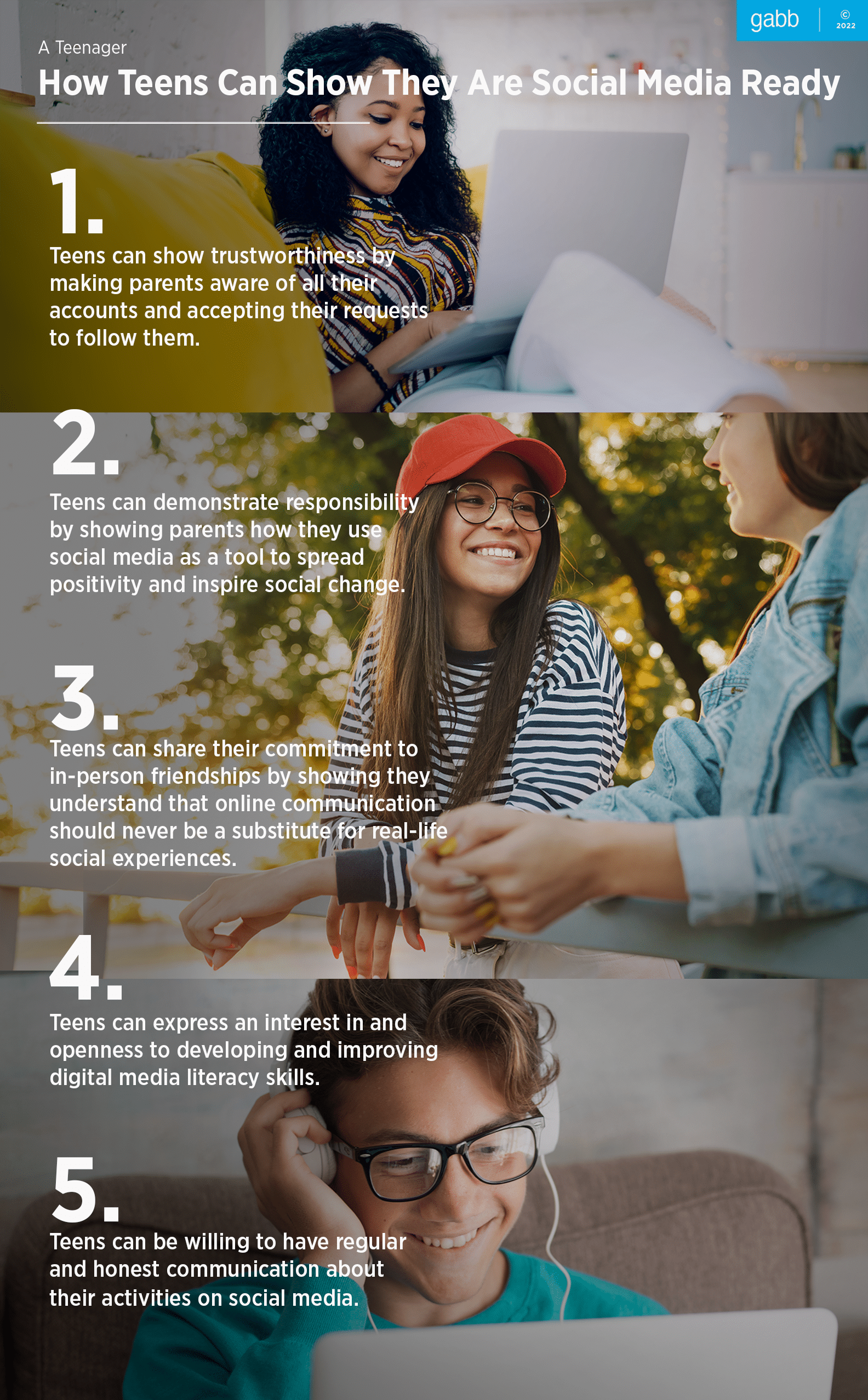Finstas are popular tools adolescents use for private self-expression, exploration, escape, and social interaction.5
Because of their secretive nature, parents naturally have a lot of questions about them:
- What is a Finsta?
- How do I find my teen’s Finsta?
- How do I talk to my child about their Finsta?
- How do I set boundaries around my teen’s Finsta?
If there are questions, we’ve got answers. Let’s dive into learning more about Finstas.
What Is a Finsta?
A Finsta account—a fake Instagram account—is an additional, private Instagram account shared only with a teen’s closest friends.
In comparison, the average Rinsta account—a real Instagram account—might have over 1000 followers and follow nearly 800 people. Finsta accounts are far more private, averaging only 61 followers and 63 people following.5
The appeal to making a Finsta account lies in its ability to provide freedom from social pressure.
Traditional Instagram accounts follow a complex system of unspoken rules where users are expected to present only the best versions of themselves.

On a user’s real Instagram account, unflattering, negative, or rambling content is looked down on.9
Because of this, teens feel obligated to spend time and energy carefully editing pictures and meticulously creating captions before posting.
In contrast, Finsta accounts give teens freedom from traditional social media constraints and expectations.9 Since only their closest, most intimate group of friends follow these private accounts, there is less pressure to look or act a certain way.
The privacy and opportunity Finstas offer is so alluring that it is not uncommon for teens to have multiple Finsta accounts.
They can post embarrassing photos, long-winded rants, and self-deprecating stories here. They don’t have to worry about “What will my peers think?” “What will my parents think?” or “What will my employer think?”
Having several accounts gives teens space to present multiple personas that fit different situations and appeal to different friends and audiences.
Ironically, a Finsta can be a more accurate reflection of the creator’s true identity, and for this reason alone, following this account provides parents with insight into their teenager’s world.
Finding Your Child’s Finsta: Open Communication Is Key
Having a Finsta isn’t necessarily negative. Still, under certain circumstances, these accounts can be dangerous.
When kids keep their Finsta a secret, risks and dangers are exacerbated. Transparency helps keep kids safe.
Parents are right in feeling they should know about and have access to all of their children’s accounts.
Follow the tips below to start open conversations about all of your teen’s accounts and the access you will have. In an effort to keep kids safe, honesty will create better outcomes for everyone involved.
How to Find Your Child’s Finsta
- Ask your child.
- Check their phone together and have a conversation.
- Let your child know that you follow their friends’ accounts.
- Together, search for their email or phone number and have them show you their additional profiles.
Ask questions
As a family, no matter your child’s age and stage, it is always a good time to talk about social media use. Discussing family boundaries surrounding Finstas is important.
We can use these conversations as an opportunity to know our children better and to explore why they’re motivated to have an additional account(s).
Check accounts together
Kids need to know that their parents are informed about Finstas. Together, open up the Instagram app on your child’s phone.
In the profile tab, their username will be at the top of the screen. Next to this is an upside-down caret symbol.
Any additional Instagram accounts your teen is logged into on their phone will be seen by clicking on this.
Follow friend accounts
Healthy conversations include chatting about friends’ profiles. Together, look at pictures that your child is in.
If you don’t recognize some of the usernames in these pictures, you might have found some Finsta accounts created by friends.
Ask your child to tell you about how their friends use Finsta and to show you their posts.
Even when hard conversations don’t go as planned, your child will know you care because you cared enough to talk.
Healthy communication never looks like an interrogation, but it’s easy to slip into detective mode. Be aware, and just try your best.
Check out this article to learn more about how and why kids hide apps.

How to Talk to Kids About Finstas
No matter your feelings or confidence level in approaching your child about Finsta, simply initiating the conversation and keeping the lines of communication open will send the message that you care deeply about your child’s happiness, safety, and security.
Healthy Ways to Talk to Kids About Finstas
- I want to talk with you about Finstas because I love you. I’m not sure exactly what to say, but I trust we can figure it out, even if I say it wrong.
- You’re a smart, capable individual, and I trust you. Because of this, I want to talk with you about Finstas.
- I think you are someone worth getting to know. Is it okay if I ask your thoughts and feelings about Finstas?
- I value your thoughts and opinions. Can we talk about Finstas?
How Finstas Can Be Harmful, Even Dangerous
When you talk to your kids about Finstas, you may find they don’t necessarily understand how a Finsta can be dangerous. Sharing this information with them builds trust and shows love.
Let them know your goal isn’t to control or punish them but rather to protect and empower them.
Assure them you recognize that having a Finsta account isn’t automatically a bad thing, but explain that it can become dangerous in some situations.
How to Set Boundaries With Older Teens Around Instagram
Our children want to be stakeholders in decisions surrounding technology.
Having an open dialogue is the first step in helping them recognize the benefits and risks of social media.
Help teens show they are ready for social media
Showing high love with high expectations works. Teens need to know how to show they are trustworthy when using social media.
Encourage kids to proactively demonstrate their understanding of internet safety and digital literacy.
Parents are not powerless to protect kids from misusing social media accounts. There are many things you can do to help them get behind boundaries.
You can check out this article about setting boundaries with kids around tech to get started. Additionally, think about these suggestions:
Educate often
New threats from social media to mental, emotional, and physical health emerge regularly. Share news stories and other reports regularly.
Kids are less likely to rebel against rules when they understand the “why” behind them.6
Invite kids to keep a journal for a week to record how much time they spend on Instagram and how they feel afterward.
Education is most powerful when the learner follows a process of self-discovery.4
Parents who accept this challenge will show solidarity with their children by using technology in healthy ways and amounts.

Offer alternatives
When setting boundaries, it is helpful to provide alternative activities.2 Not only does this provide more opportunities to fulfill their core psychological needs, but it also gets them interested in living life beyond the screen.
Consider the need that social media is fulfilling for your child and brainstorm healthier and more effective ways to meet it.

Wrap-up
Finsta is popular with teens because adolescence is a time of exploration and self-discovery.
You can empower your teens and keep them safe by learning more about them and their relationship with social media. You don’t have to be a perfect parent to be able to do this.
Simply reading this article shows you want to be aware because you care; that’s a great start.
Share this article with family and friends
References
- Barlett, C. P., Gentile, D. A., & Chew, C. (2016). Predicting cyberbullying from anonymity. Psychology of Popular Media Culture, 5(2), 171–180
- Carlson S. A., Fulton J. E., Lee S. M., Foley J. T., Heitzler C., & Huhman M. (2010). Influence of limit-setting and participation in physical activity on youth screen time. Pediatrics, 126(1), e89-96. https://doi.org/10.1542/peds.2009-3374
- Chassiakosa, Y. R. & Stage, M. (2020). Current trends in digital media: How and why teens use technology. In Moreno, M. A. & Hoopes, A. J. (Eds.), Technology and adolescent health: In schools and beyond (pp. 25-56). Elsevier Inc.
- Heath, C. & Heath, D. (2017). The power of moments. Simon and Schuster.
- Kang, J. & Wei, L. (2020) Let me be at my funniest: Instagram users’ motivations for using Finsta (a.k.a., fake Instagram). The Social Science Journal, 57(1), 58-71
- Ko, M., Choi, S., Yang, S., Lee, J., & Lee, U. (2015). “FamiLync: Facilitating participatory parental mediation of adolescents’ smartphone use.” In Proceedings of the 2015 ACM International Joint Conference on Pervasive and Ubiquitous Computing, 867–878
- Koestner, K., Ryan, R. M., Bernieri, F., & Holt, K. (1984). “Setting limits on children's behavior: The differential effects of controlling vs. informational styles on intrinsic motivation and creativity.” Journal of Personality, 52(3), 233-248
- Purswell, K. E. (2020). An exploration of limit-setting in child counseling. Journal of Child and Adolescent Counseling, 6(3), 228-241
- Schoenfeld, R. R., & Fiori, K. L. (2021). All Social Media Are Not Created Equal: Instagram, Finsta, and Loneliness. Journal of Social, Behavioral & Health Sciences, 15(1), 258–277











Success!
Your comment has been submitted for review! We will notify you when it has been approved and posted!
Thank you!